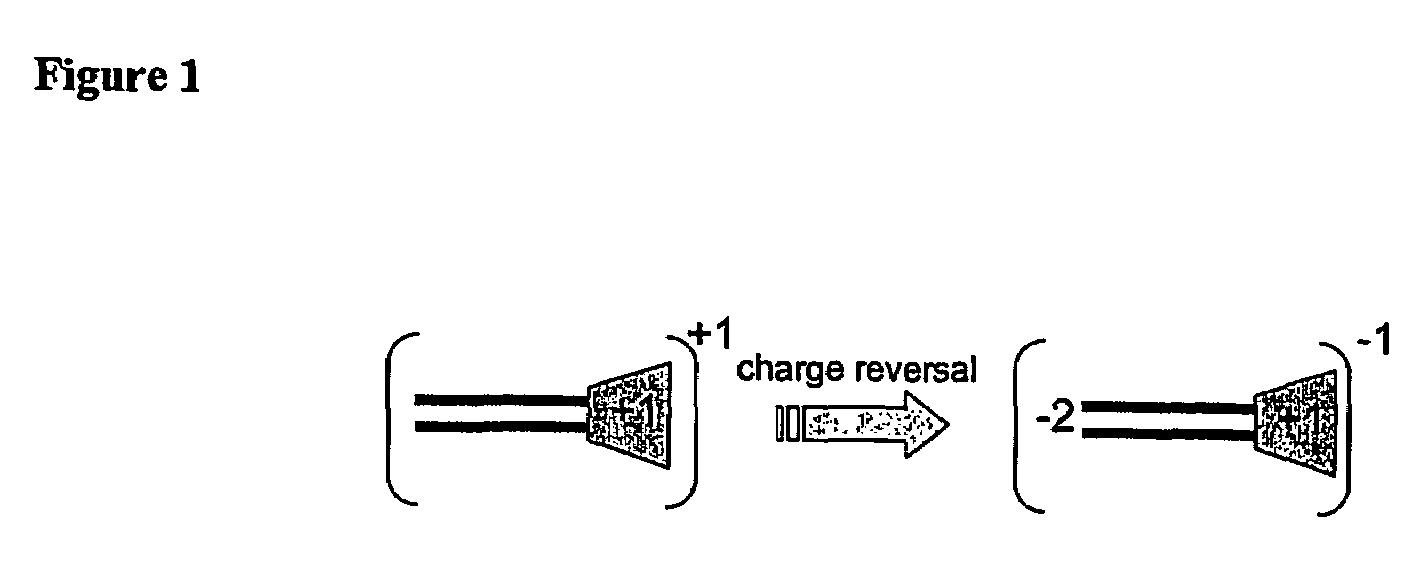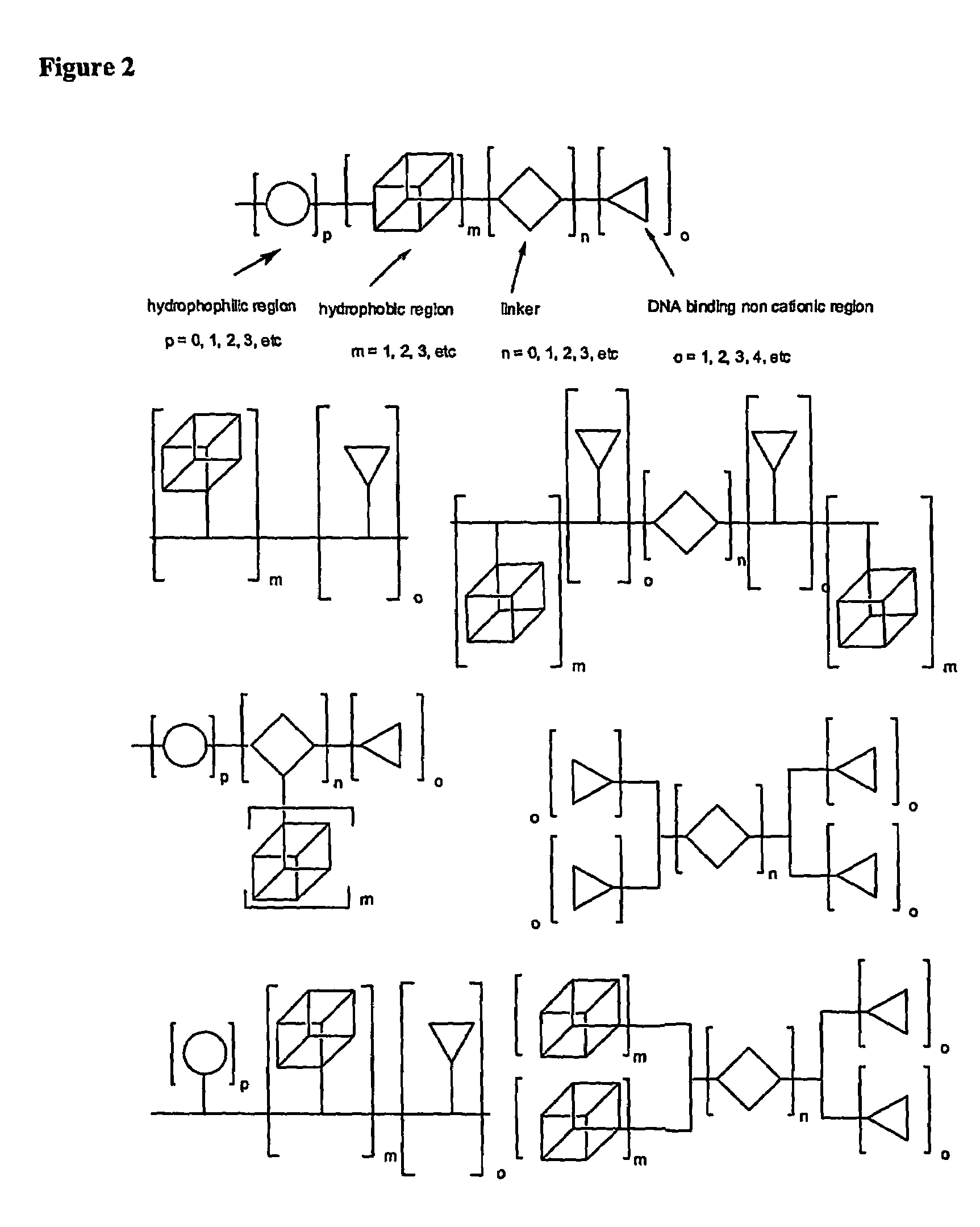Functional synthetic molecules and macromolecules for gene delivery
a technology of macromolecules and synthetic molecules, applied in the field of gene delivery, can solve the problems of dna naturally having poor affinity for the plasma membrane of cells, unable to penetrate a nucleic acid into a cell or target organ, and unable to meet the needs of human immune response to treatmen
- Summary
- Abstract
- Description
- Claims
- Application Information
AI Technical Summary
Benefits of technology
Problems solved by technology
Method used
Image
Examples
example 1
[0652]
Resin Trityl Uridine (Compound 1a)
[0653]Trityl resin (1 g, 0.9 mM; 1 eq) was suspended in 40 mL of freshly distilled methylene chloride and pyridine (1 / 1). Uridine (0.330 g, 1.35 mM, 1.5 eq) and a catalytic amount of N,N-dimethyl aminopyridine were added to the reaction flask. After five hours at room temperature the resin is filtered off and washed three times with 20 mL of methylene chloride and dried under high vacuum. The characterization data were consistent with the proposed structure.
2′,3′dimyristoyl uridine (Compound 3b)
[0654]Myristic acid (0.7 g, 3.06 mmol, 3.4 eq), dicyclohexylcarbodiimide (0.63 g, 3.06 mmol, 3.4 eq), and a catalytic amount of N,N-dimethyl aminopyridine were dissolved in dry methylene chloride. Resin 1a was then added to the reaction mixture. The suspension was shaken for 24 hours at room temperature. The resin was washed three times with 20 mL of methylene chloride and isolated by filtration under suction. The resulting dried beads were stirred with...
example 2
[0657]
5′-O-(4,4′-dimethoxytrityl)uridine (Compound 1b)
[0658]Chlorodimethoxytrityl (2.0 g, 5.9 mmol, 1.3 eq), uridine (1.1 g, 4.5 mmol, 1 eq), and a catalytic amount of N,N-dimethyl aminopyridine were dissolved in 25 mL of pyridine. The reaction mixture was stirred for 24 hours at room temperature. Pyridine was removed under vacuum and the resulting crude material was purified on silicagel (DCM / MeOH 95 / 5) to yield 2.14 g of the expected product 1b. (Yield: 87.1%). The characterization data were consistent with the proposed structure.
5′-O-(4,4′-dimethoxytrityl)-2′,3′-dimyristoyl uridine (Compound 2b′)
[0659]Compound 1b (0.50 g, 0.91 mmol, 1 eq), myristic acid (0.46 g, 2.01 mmol, 2.2 eq), dicyclohexylcarbodiimide (0.41 g, 2.01 mmol, 2.2 eq), N,N-dimethylaminopyridine (0.24 g, 2.01 mmol, 2.2 eq) were dissolved in 100 mL of freshly distilled methylene chloride. The mixture was stirred for 24 hours at room temperature under nitrogen. After filtration, the organic phase was successively was...
example 3
[0662]
5′-PEG-2′,3′-dimyristoyl uridine (Compound 4b)
[0663]Compound 3b (10 mg, 0.015 mmol, 1 eq), methoxy-PEG5000-carboxymethyl (75 mg 0.015 mmol, 1 eq), dicyclohexylcarbodiimide (10 mg, 0.05 mmol, 3.3 eq), and a catalytic amount of N,N-dimethylaminopyridine were dried for one hour under high vacuum. Then, the starting material was dissolved under nitrogen in 5 mL of freshly distilled methylene chloride. The mixture was stirred for 6 days at room temperature under nitrogen. After filtration, the solvent was removed and the resulting crude product was purified with a LH20 size exclusion column in DCM / MeOH 50 / 50. The product (56 mg) was isolated after precipitation in methanol / ether. (Yield: 64%). The characterization data were consistent with the proposed structure.
5′-PEG-2′,3′-disteroyluridine (Compound 4d)
[0664]A similar procedure was followed as for product 4b. Compound 3d (50 mg, 0.064 mmol, 1 eq), methoxy-PEG5000-carboxymethyl (321 mg, 0.064 mmol; 1 eq), dicyclohexylcarbodiimide ...
PUM
| Property | Measurement | Unit |
|---|---|---|
| temperature | aaaaa | aaaaa |
| pH | aaaaa | aaaaa |
| molecular weight | aaaaa | aaaaa |
Abstract
Description
Claims
Application Information
 Login to View More
Login to View More - R&D
- Intellectual Property
- Life Sciences
- Materials
- Tech Scout
- Unparalleled Data Quality
- Higher Quality Content
- 60% Fewer Hallucinations
Browse by: Latest US Patents, China's latest patents, Technical Efficacy Thesaurus, Application Domain, Technology Topic, Popular Technical Reports.
© 2025 PatSnap. All rights reserved.Legal|Privacy policy|Modern Slavery Act Transparency Statement|Sitemap|About US| Contact US: help@patsnap.com



